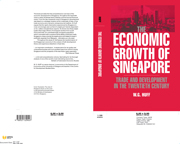Book contents
- Frontmatter
- Contents
- List of figures
- List of tables
- Preface and acknowledgements
- Abbreviations and conventions
- Geographical definitions
- Introduction
- Part One Themes and beginnings
- Part Two Development as a staple port, 1900–1939
- 3 Trade, finance and development
- 4 Ocean-going shipping, the port and regional transport
- 5 Immigration, population and employment
- 6 Rubber: boom and spread of a twentieth-century staple
- 7 Rubber, industrialization and the development of Chinese banking
- 8 Petroleum and tin: the twentieth-century boom commodity and a staple in decline
- 9 The distribution of manufactured imports
- Part Three Staple port and rapid growth, 1947–1990
- 12 Conclusion
- Appendix tables
- Bibliography
- Index
8 - Petroleum and tin: the twentieth-century boom commodity and a staple in decline
Published online by Cambridge University Press: 22 September 2009
- Frontmatter
- Contents
- List of figures
- List of tables
- Preface and acknowledgements
- Abbreviations and conventions
- Geographical definitions
- Introduction
- Part One Themes and beginnings
- Part Two Development as a staple port, 1900–1939
- 3 Trade, finance and development
- 4 Ocean-going shipping, the port and regional transport
- 5 Immigration, population and employment
- 6 Rubber: boom and spread of a twentieth-century staple
- 7 Rubber, industrialization and the development of Chinese banking
- 8 Petroleum and tin: the twentieth-century boom commodity and a staple in decline
- 9 The distribution of manufactured imports
- Part Three Staple port and rapid growth, 1947–1990
- 12 Conclusion
- Appendix tables
- Bibliography
- Index
Summary
To enjoy one mineral boom in little more than half a century – as Singapore did with tin – might be described as fortunate; to benefit from two – as happened from World War I onwards when the region around Singapore became a large petroleum producer – can only be described as uncommonly lucky. The growth of the port's petroleum trade was spectacular, and in the mid-1930s caused a traveller returning after 25 years to think ‘the numerous islands with which the entrance to Singapore is studded … an indication of the new Singapore. Where formerly all had been greenness were now great patches of hard yellow soil disfigured by huge oil tanks’. Yet prior to World War II petroleum created few major linkages, while some important linkages associated with tin production weakened. The two commodities contrasted with rubber's strong linkage effects, and serve as a reminder that staples may differ greatly in their spread effects over time.
During the inter-war period petroleum in many ways remained an enclave industry. Physically it did not enter Singapore except for the island's own use, and since the product was not owned by Singapore residents, there was no petroleum market in Singapore. Petroleum imports and exports relied on a new set of entrepreneurs, the international oil companies, which did not need the assistance of Singapore firms as managers or to raise capital.
- Type
- Chapter
- Information
- The Economic Growth of SingaporeTrade and Development in the Twentieth Century, pp. 236 - 256Publisher: Cambridge University PressPrint publication year: 1994

